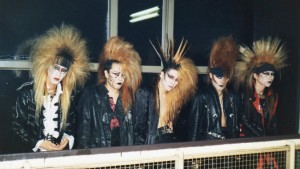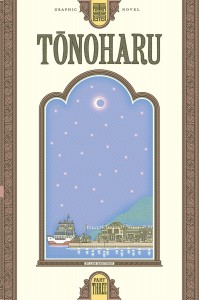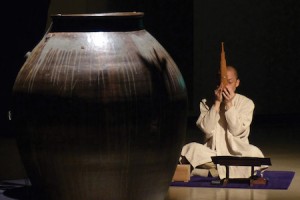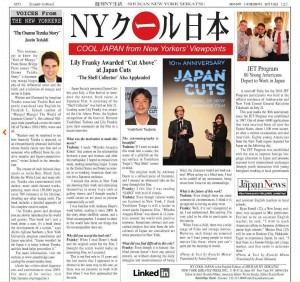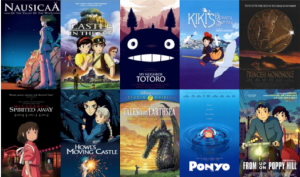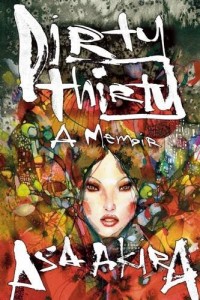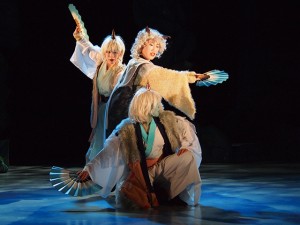JQ Magazine: Book Review — The ‘Tonoharu’ Trilogy
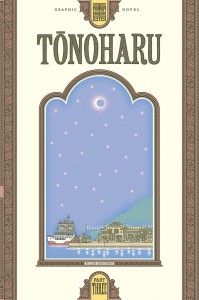
“This graphic novel series arrests your attention, from the immersive quality of the art, to the highs of self depreciating humor, to the lows of isolation and despair that run through it. Those who have lived abroad will find much to relate to.” (Top Shelf Productions)
By Julio Perez Jr. (Kyoto-shi, 2011-13) for JQ magazine. A bibliophile, writer, translator, and graduate from Columbia University, Julio currently keeps the lights on by working at JTB USA while writing freelance in New York. Follow his enthusiasm for Japan, literature, and comic books on his blog and Twitter @brittlejules.
Everyone has felt out of place at some point in their lives. People who choose to live abroad sometimes make that their everyday. In Tonoharu, cartoonist and JET alum Lars Martinson (Fukuoka-ken, 2003-2006; Kyoto-fu, 2011-2016) illustrates a story exploring themes of human relationships through the experience of an English teacher in Japan on a journey of self-discovery. Told in three parts, the final volume was released in November and represents many years of work for Martinson that began to see fruition when he received the Xeric Grant for Comic Book Self-Publishers in 2007.
Tonoharu is a tale of several non-Japanese teachers of English living in the titular rural town outside of Fukuoka City, mostly from the viewpoint of a young American named Dan Wells. Wells feels out of place in Japan, but claims to have felt the same way back home without having the excuse of being a foreigner. The reader climbs in the back seat for an intimate road trip with him through his pursuit of purpose and success in his job and social life, privy to all manner of encounters from intimacy in the bedroom to traditional parades with locally made floats. In just one year, Wells encounters unique challenges in his work, frustrations with seemingly unrequited romantic interest for another American, confusion and alarm at the mysterious activities of other foreigners in Tonoharu, and worst of all, the inability to replace light bulbs in his apartment!
Tonoharu is full of quiet moments that when described may come off as unimpressive, but they are always captivating and powerful in the way the words and imagery captures the moodiness of imperfect exchanges between people that are not usually seen in glossier fiction. This quality is enhanced by a lack of narration—the framing story of Dan’s successor (also named Dan) features his narration, but in the main story the characters only express themselves by speaking to one another. Often the things they don’t say, their expressions and their body language, and the things they choose to say while alone, speak just as powerfully as the introspective autobiographical style of narrative-driven graphic novels such as Persepolis.
JQ Magazine: Manga Review — ‘Kitaro Meets Nurarihyon’
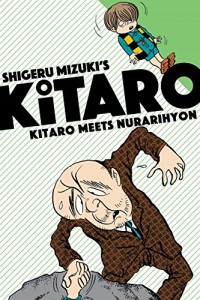
“If you are a lover of the weird or irreverent comedy mixed with supernatural horror, manga, and Japanese folklore-inspired fiction, then find the spiritual world portal of your choice to get your hands on a copy of Kitaro Meets Nurarihyon.” (Drawn and Quarterly)
By Julio Perez Jr. (Kyoto-shi, 2011-13) for JQ magazine. A bibliophile, writer, translator, and graduate from Columbia University, Julio currently keeps the lights on by working at JTB USA while writing freelance in New York. Follow his enthusiasm for Japan, literature, and comic books on his blog and Twitter @brittlejules.
Imagine coming home to find a stranger in your house. He acts like he owns the place, eats your food and drinks your beer, before leaving you reeling in confusion! Better send a letter to the Yokai Post for help from Kitaro, a charming character made by manga legend Shigeru Mizuki. Kitaro investigates strange phenomena and protects humans from ill-intentioned yokai.
Shigeru Mizuki’s Kitaro – Kitaro Meets Nurarihyon is a manga volume collecting seven more of Kitaro’s paranormal adventures. While this book can be enjoyed as a stand-alone dive into the classic character’s adventures, your enjoyment can be enhanced by checking out Kitaro’s origin story featured in the first volume, The Birth of Kitaro, reviewed last year by JQ here. This book is one of several entries in a list of literary delights from Japan that Drawn and Quarterly has been bringing to America for affordable access. This volume was also translated by JET Alum and Shigeru Mizuki expert/JQ interviewee Zack Davisson (Nara-ken, 2001-04; Osaka-shi, 2004-06).
Like it says on the tin, in this book Kitaro encounters a uniquely urban yokai: Nurarihyon. This creature takes on the appearance of an unsettling-looking and self-important man to stealthily wreak havoc as mundane as forcing you to serve him your best snacks and as extreme as explosions in cities.
Many of the yokai Kitaro encounters cause trouble because it is in their nature, some have a need to feed, or have a human-like impulse that persists beyond the grave, but Nurarihyon is cut from a different cloth. He is simply cruel and makes mischief because of his hatred for humans. He also stands apart from others in Kitaro’s rogues gallery because he finds it repulsive that Kitaro helps humans and targets him for that reason. You’ll have to pick up the book to find out just how Nurarihyon plots Kitaro’s demise, and how he very nearly gets away with it!
JQ Magazine: Book Review — ‘Womansword’
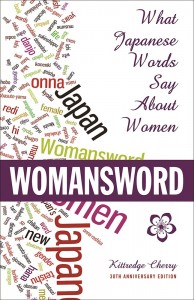
“Even if Womansword is an unintended trip back to the ’80s, it is a fascinating read and a striking reminder of how language can reflect the general mindset and culture of society.” (Stone Bridge Press)
By Rashaad Jorden (Yamagata-ken, 2008-10) for JQ magazine. A former head of the JETAA Philadelphia Sub-Chapter, Rashaad is a graduate of Leeds Beckett University with a master’s degree in responsible tourism management. For more on his life abroad and enthusiasm for taiko drumming, visit his blog at www.gettingpounded.wordpress.com.
Sometimes, I might come across a book that makes me feel as if I don’t know anything about Japan. Not that I didn’t learn a lot about the country during my JET days, but that the book contains so much information, it puts to shame what I’ve learned about Japan.
Such is the feeling I experienced while reading Womansword: What Japanese Words Say About Women. First published in 1987, the book examines Japan through the language used to describe women and the terms frequently employed by women. This new 30th anniversary edition of Kittredge Cherry’s work seems to be the perfect setting to learn about women’s issues I had never thought of.
And it certainly was, although I got a feeling from the book that I once experienced while observing the fashion sense of people attending a flea market in Yoyogi Park: everything is stuck in the ’80s. (More on that later.)
Womansword is divided into seven chapters that address themes such as motherhood, sexuality and aging. It provides relevant information before reaching the first chapter as the “Preface to the 30th Anniversary Edition” includes several details on how the landscape for women in Japan has changed—and hasn’t changed. The good news: In 1991, for the first time in history, more than half of Japanese women had entered the workforce. And in 2015, Prime Minister Shinzo Abe announced several measures to reverse the country’s shrinking birth rate as part of his Abenomics economic plan. On the other hand, Japan ranked 105th out of 136 countries in the 2014 Global Gender Gap Report and in the following year—more than 30 years after the Equal Employment Law was passed—Japanese women still earned lower pay and fewer promotions on average.
JQ Magazine: Book Review — ‘I Want That Love’
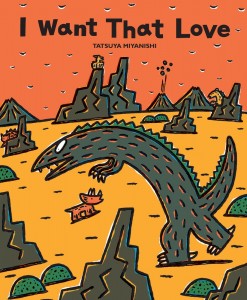
“I Want That Love is a very enjoyable read that teaches the importance of friendship, love and tenderness. Young readers will also learn how life’s most important lessons can be passed down from generation to generation.” (Museyon)
By Rashaad Jorden (Yamagata-ken, 2008-10) for JQ magazine. A former head of the JETAA Philadelphia Sub-Chapter, Rashaad is a graduate of Leeds Beckett University with a master’s degree in responsible tourism management. For more on his life abroad and enthusiasm for taiko drumming, visit his blog at www.gettingpounded.wordpress.com.
During your elementary school days, you surely read about the primordial creatures you know as dinosaurs. But if you haven’t been reminded of the creatures that roamed the earth roughly 65 million years ago in some time, you might not realize that there’s more than meets the eye. Case in point: Tatsuya Miyanishi’s I Want That Love.
I Want That Love (the third book in Miyanishi’s Tyrannosaurus series of 13 titles that have sold more than three million copies internationally) tells the story of a Tyrannosaurus, who is described by the author as “the strongest of all the dinosaurs.” Not surprisingly, everyone is scared of him as he never fails at getting his way by force. But the good times don’t last—the Tyrannosaurus (whose name is revealed to be Mr. Rhadbodon)—is somehow sapped of his strength after being bitten in his tail by a Masiakasaurus.
As expected from someone whose identity is clearly tied to brute force, the Tyrannosaurus loses all sense of who he is, so he’s desperate to find any solution to the disaster that has befallen him. Fortunately, he receives help in the form of berries given to him by fellow creatures and he uses his newfound energy to protect his friends from other dinosaurs.
JQ Magazine: Nippon in New York — ‘We Are X,’ ‘Tonoharu,’ VAMPS, Momoiro Clover Z
By JQ magazine editor Justin Tedaldi (CIR Kobe-shi, 2001-02). Justin has written about Japanese arts and entertainment for JETAA since 2005. For more of his articles, click here.
From the silver screen to the stage to J-pop, November is just as colorful as the autumn leaves drifting through the air. Add these live events to the mix and you’ve got an irresistibly epic rundown.
This month’s highlights include:
Friday, Nov. 4, various times
Alamo Drafthouse Downtown Brooklyn, 445 Albee Square West
$11
East Coast premiere! This award-winning documentary debuted at Sundance and SXSW earlier this year chronicles the back story of the hard rock band X Japan, as its star drummer Yoshiki prepares for a reunion concert at Madison Square Garden. While virtually unknown to U.S. audiences, Yoshiki has sold more than 30 million records overseas, where he enjoys an A-list following. Directed by Stephen Kijak (Stones in Exile) and produced by John Battsek (Searching for Sugar Man), We Are X includes testimonials from such high-profile X fans as Gene Simmons and Marilyn Manson. See Yoshiki and director Stephen Kijak in person for Q&A on Fri, 11/4 following the 7:30 p.m. show. Director Stephen Kijak appears in person for Q&A Sat, 11/5 following the 6:30 p.m. show.
Tuesday, Nov. 8
$24.95
The long-awaited final volume of the critically acclaimed Tonoharu series from JET alum Lars Martinson (Fukuoka-ken, 2003-2006) rejoins Dan Wells several months into his tenure as an English teacher in the Japanese village of Tonoharu. As personal stresses push Dan to the breaking point, he decides to take an extended cross-country vacation to let off steam. His time away grants him a fresh perspective on his troubles, but upon his return to Tonoharu, Dan discovers that dramatic change has occurred in his absence. Will this upheaval render his new-found epiphany moot? With hundreds of beautiful, detailed illustrations that evoke 19th century line engravings, Tonoharu provides a nuanced portrayal of the joys and frustrations of living abroad.
Friday, Nov. 11, 8:30 p.m.
Sounds to Summon the Japanese Gods: Ko Ishikawa
Japan Society, 333 East 47th Street
$20, $15 Japan Society members. A limited number of Lobby Seats are available for purchase. Please call the box office at (212) 715-1258 to inquire.
Step into a space where otherworldly sounds abound. Led by Ko Ishikawa, master player of the sho (ancient Japanese mouth organ) and internationally active contemporary musician, this program offers selections spanning from medieval gagaku (Imperial Court music) to works by acclaimed music composer Mamoru Fujieda. Ishikawa will be joined by Kayoko Nakagawa on koto and Ami Yamasaki on voice for this musical soiree, which also incorporates the sounds of fermenting shochu (Japan’s distilled alcohol), a highly sacred beverage in Japanese mythology.
JQ Magazine: Book Review — ‘Are You an Echo?’
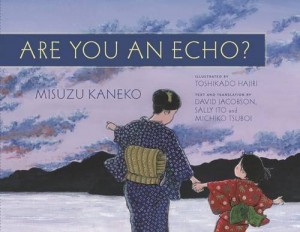
“This is an outstanding collection of poems that reflects a wide variety of emotions and observations while giving readers new and colorful images of Japan.” (Chin Music Press)
By Rashaad Jorden (Yamagata-ken, 2008-10) for JQ magazine. A former head of the JETAA Philadelphia Sub-Chapter, Rashaad is a graduate of Leeds Beckett University with a master’s degree in responsible tourism management. For more on his life abroad and enthusiasm for taiko drumming, visit his blog at www.gettingpounded.wordpress.com.
As we might take for granted the ability to research anything and everything quickly, it’s easy to forget how much of a struggle it has been (and still might be) to discover fascinating aspects of history. But when those discoveries are made, it’s satisfying not just for those who make the extensive effort—it’s rewarding for those who have benefited from the discoveries.
Thanks to fellow author Setsuo Yazaki, English-language speakers from all over the world now have the opportunity to read Are You an Echo? The Last Poetry of Misuzu Kaneko, a collection of poems produced by the late lauded children’s writer. Yazaki was a young student when he read Misuzu’s poem “Big Catch,” and he was automatically intrigued by her. So he wanted to discover more of her works and immediately started trying to find them—only to run into run one obstacle after another. Finally, Setsuo made a breakthrough when he was able to reach Misuzu’s younger brother Masasuke (then 77 years of age), who handed Yazaki a set of diaries, which included poems Misuzu wrote.
A prolific writer, Misuzu’s works regularly appeared in popular magazines. She wrote 512 poems, but only a few of them appear in Are You an Echo? Even so, that small sample size is enough to give you a glimpse into her life. Misuzu grew up in a fishing village in western Japan, and she loved being around water (she wrote one poem about an island she visualized but couldn’t reach). She also had a very vibrant imagination, and everything she encountered had feelings, like snowflakes (she’s actually concerned about their well-being) or telephone poles (which at one point, got sleepy). Even cicadas wore clothes in Misuzu’s world.
JQ Magazine: Book Review — ‘Tokio Whip’

“Although Tokio Whip can be a difficult read, reading it actually resembles being in the city. You’ll learn things that are mind-blowing while wondering what exactly is going on.” (Stone Bridge Press)
By Rashaad Jorden (Yamagata-ken, 2008-10) for JQ magazine. A former head of the JETAA Philadelphia Sub-Chapter, Rashaad is a graduate of Leeds Beckett University with a master’s degree in responsible tourism management. For more on his life abroad and enthusiasm for taiko drumming, visit his blog at www.gettingpounded.wordpress.com.
Those who look fondly at their JET experience often feel that the people they met and the places they frequented greatly shaped their time in Japan. But as a lot of us—if not most of us—former JETs lived outside of the big cities, it might be interesting to read about how life in the capital might be influenced by people and places.
So Arturo Silva’s Tokyo Whip might just serve as a look at the capital that fascinates you. Silva, a native of the United States who spent the ‘80s and ‘90s in Tokyo, uses first person voice to take readers on a tour of the city experienced by Roberta and Lang, two Westerners living in the Japanese capital, and their friends. A story about life in Tokyo is probably interesting in itself. But another important story is brewing in Tokio Whip: Lang is a film director and he has created a 144-minute work divided into six scenes whose settlings include locations such as the Rikugien Garden, Seibu Ikebukuro Department Store, and Shinjuku Station—all of those being places you might be familiar with.
Most of Tokio Whip takes place in the heart of the city as Silva aims to create a novel similar to a tour of Tokyo people might go on. Even if the book really isn’t a circular tour of Tokyo, reading Tokio Whip will surely bring about some natsukashii moments or thoughts, such as one character who spent twenty minutes in Shinjuku Station looking for an exit or another character still getting lost in Shibuya Station despite being there hundreds of times.
JQ Magazine: Book Review — ‘Diary of a Tokyo Teen’
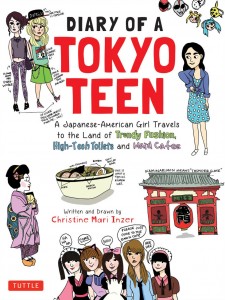
“Through reading her travelogue, Inzer comes across as a writer who would make an excellent travel blogger, as she gives prospective visitors to Japan fascinating tidbits about the country’s culture and attractions.” (Tuttle Publishing)
By Rashaad Jorden (Yamagata-ken, 2008-10) for JQ magazine. A former head of the JETAA Philadelphia Sub-Chapter, Rashaad is a graduate of Leeds Beckett University with a master’s degree in responsible tourism management. For more on his life abroad and enthusiasm for taiko drumming, visit his blog at www.gettingpounded.wordpress.com.
You may remember being treated to “What I did during my summer vacation” tales in elementary school. Well, Christine Mari Inzer spent a memorable summer vacation visiting family in Japan and she documents those travels in a largely visual journey entitled Diary of a Tokyo Teen.
Originally published independently in 2014, this updated, expanded edition is in gorgeous full color and includes over 20 new comics and photos in a large-size format (7.5” x 10”) — all at a very affordable price.
The spirited daughter of a Japanese mother and American father, Inzer describes herself as being half at home in the United States and half at home in Japan, and summarizes her travels through a collection of photos, illustrations (all self-drawn), and anecdotes. Geared toward young adults (the author is currently a student at the University of Richmond), Inzer details the ups and downs of travel while humorously detailing some moments of aggravation, such as her frustration with the shyness of Japanese boys.
JQ Magazine: Manga Review — ‘The Osamu Tezuka Story’
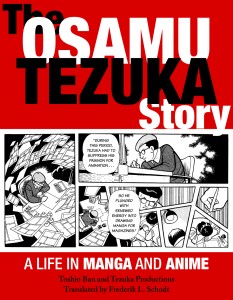
“Gargantuan in size at 928 pages (including detailed appendixes), this manga-format biography is a surprisingly quick read. Its fast-paced visuals and story provide a unique vantage to observe a legendary figure that leaves you energized after each sitting.” (Stone Bridge Press)
By Alexis Agliano Sanborn (Shimane-ken, 2009-11) for JQ magazine. Alexis is a graduate of Harvard University’s Regional Studies-East Asia (RSEA) program, and currently works as a program coordinator at the U.S.-Asia Law Institute of NYU School of Law.
For many, the newest publication from Stone Bridge Press will seem like a long lost friend. Originally serialized in 1989 and completed in 1992, The Osamu Tezuka Story: A Life in Manga and Anime, written and illustrated by Toshio Ban in association with Tezuka Productions and translated by Frederik L. Schodt, is a book worth the wait. Gargantuan in size at 928 pages (including detailed appendixes), this manga-format biography is a surprisingly quick read. Its fast-paced visuals and story provide a unique vantage to observe a legendary figure that leaves you energized after each sitting. Whether you first learned about manga and anime yesterday, five years ago, or have been a diehard fan for decades, this book has something to offer.
Manga and anime artist Osamu Tezuka carries the weight that Walt Disney carries in the West. His vision, ingenuity, and motivation defined and propelled the bourgeoning manga and anime industry of the fifties, sixties, and seventies. This book follows Tezuka through it all: from his birth in Osaka in 1928 to his death in 1989, and everything in between. Through him, we see 1930s Japan and the rise of militarism, the authoritarian interwar, the penurious postwar, and the gradual rebirth and growth leading to the booming days of the 1980s. In his lifetime, Tezuka experienced it all—feast and famine, war and peace—and it is fervently captured in his artwork and stories.
This book is written and illustrated by Toshio Ban, a longtime animator and friend of Tezuka. Carefully researched and painstakingly detailed, Ban covers everything from Tezuka’s lifelong fascination of insects, his struggle balancing his academic passion of medicine, and his artistic passion of manga and anime, to his various commutes between Takarazuka City and Tokyo. While some details are lacking (for example, the reasons behind his first animation studio Mushi Production’s bankruptcy and financial problems), Ban has created a work exhaustive as it is fascinating.
Justin’s Japan: ‘The Osamu Tezuka Story’
By JQ magazine editor Justin Tedaldi (CIR Kobe-shi, 2001-02) for Shukan NY Seikatsu. Justin has written about Japanese arts and entertainment for JETAA since 2005. For more of his articles, click here.
This summer, get to know the “God of Manga.”
From Stone Bridge Press comes “The Osamu Tezuka Story,” a documentary manga biography of the influential artist and the birth and evolution of manga and anime in Japan.
Written and illustrated by longtime Tezuka associate Toshio Ban and newly translated into English by Frederik L. Schodt (author of “Manga! Manga! The World of Japanese Comics”), this colossal 928-page trade paperback covers the entire life of Tezuka (1928-1989), warts and all.
“Readers may be surprised to see how honestly Tezuka is depicted, as an extraordinarily obsessed individual whose family rarely saw him and as someone who suffered from his creative impulse and hyper-competitiveness,” writes Schodt in the introduction.
The creator of such beloved characters as Astro Boy and Kimba the White Lion, Tezuka also experimented with darker, more adult-themed works, penning more than 150,000 pages (over 700 volumes) in his lifetime, dwarfing any other manga artist. The book includes a detailed appendix of his complete creative output.
“As Tezuka grows and develops you are slowly introduced to his world and genius. This book isn’t just a book about a man, it’s a book about the development of a nation,” says Alexis Agliano Sanborn, a New York University program coordinator and Japan specialist. “Japan wouldn’t be the Japan it is today without Tezuka, and this book helps you realize it.”
For more information, visit www.stonebridge.com/catalog/the-osamu-tezuka-story.
JQ Magazine: Nippon in New York — Studio Ghibli, Asa Akira, Liberty City Anime Con, Sekai no Owari
By JQ magazine editor Justin Tedaldi (CIR Kobe-shi, 2001-02). Justin has written about Japanese arts and entertainment for JETAA since 2005. For more of his articles, click here.
In the dog days of summer, it’s best to escape the heat in a place that’s cozy and cool. For those into Japanese cultural events, this month offers a diverse selection of film premieres and live music—all in the comfort of indoor air conditioning.
This month’s highlights include:
Various dates from Aug. 3
Village East Cinema, 181-189 Second Avenue
$10, $15
This month, Village East Cinema presents four more films from the legendary Studio Ghibli and Academy Award-winning director Hayao Miyazaki! Here’s your chance to enjoy some Japan’s greatest and most influential animated films on the big screen. The morning screenings are English dubbed versions, while the evening screenings are in Japanese with English subtitles. This month’s selections include Japan’s all-time box office champ Spirited Away (Aug. 3-4), Howl’s Moving Castle (Aug. 10-11), Tales from Earthsea (Aug. 17-18), and From Up on Poppy Hill (Aug. 31-Sept. 1).
Tuesday, Aug. 9, 2016
Asa Akira, Dirty Thirty
$12.99 Kindle, $13.64 paperback
The world knows her as a porn star…but it’s her way with words that will touch you again and again. As she contemplates turning thirty years old while still being in the adult film trade, Asa Akira delves into her past, present, and future, exploring the events that brought her to where she is now and the surprising and insightful plans she has for her future. Asa’s perceptive, funny, and straightforward writings on love, sex, death, marriage and celebrity come together in this surprising book of essays that will have you laughing hysterically one minute and deep in reverent thought the next. Personally revealing as well as universal, Dirty Thirty marks the coming of age of a new literary star.
Aug. 12-17
Flamboyán Theater at The Clemente, 107 Suffolk Street
$13-$18
OZmate, a musical theater company based in Takarazuka, proudly presents The Legend of Oni with an all-female cast as part of the New York International Fringe Festival (FringeNYC)! The Legend of Oni is a musical about two Oni, ogres in Japan, in the pre-samurai Heian period. Lose yourself in the beautiful Japanese days of old with wonderful kimono costumes under the direction of Naoko Tsujii. OZmate also appears earlier this month as part of J-Summit New York at the Bowery Electric (327 Bowery) on Sunday, Aug. 7, with additional performances by Truthseekers, LUST, Lulla LayLa, Tamuro Rie, Naoki, Megumi, Shino Frances, Takaro Nishimura, and Emi Matsushita. Doors open at 5:30 p.m.; tickets are $15 advance, $18 at the door (includes one drink).
Suzanne Kamata is a Finalist for the Half the World Global Literati Award
Author/advocate Suzanne Kamata’s (Tokushima, ’88-’90) unpublished memoir Squeaky Wheels: Travels with my Daughter by Plane, Train, Boat, Tuk-tuk, Metro and Wheelchair has been named a finalist for the initial Half the World Global Literati Award.
Sponsored by Half the World Holdings, a woman-focused investment platform, this award intends to recognize an original story, screenplay, memoir, or novel featuring one or more female protagonists as the central character, and offering “a fresh perspective on the challenges and joys of women’s lives.”
According to research by Nicola Griffith, most major literary prizes over the past fifteen years have been awarded to works that did not have a woman at the heart of the story. This award will attempt to balance the equation. An international panel will determine the winner of the $US50,000 prize, however, anyone can vote for the People’s Choice Award until July 23. Here’s a link.
Here is a brief synopsis of Squeaky Wheels:
My thirteen-year-old daughter Lilia can’t walk, but she wants to travel the world. Born fourteen weeks premature, Lilia is deaf and affected by cerebral palsy. Her primary language is Japanese Sign Language, and she uses a wheelchair to get around. At the Tokushima School for the Deaf, Tokushima, Japan, which she has attended in one capacity or another since she was about two years old, she is on the special ed track, which doesn’t include English and social studies. Even so, she is wildly curious about other countries and interested in learning her mother’s native tongue. When she told me that she wanted to go to Paris, I vowed to find a way even though I didn’t have a full-time job. In SQUEAKY WHEELS, I write about my effort to open up the world at large to my daughter as her own world seems to be shrinking. As she becomes heavier and less portable in this country short of wheelchair ramps, her accessibility has decreased. However, we attempt to confront and overcome at least some of the challenges of traveling with a wheelchair. Among other things, I write about our mother-daughter trips to the art island of Naoshima in Japan’s inland sea where we sleep in a museum; to Paris – including our arguments about what to pack and what to wear, Lilia’s response to the art and food and sights of the city, accessibility to the Eiffel Tower; and to the United States where we explore the caves of Tennessee and the monuments of Washington, DC. At the same time, I struggle to overcome my fears for the future and revise my hopes and dreams for my daughter
JQ Magazine: Manga Review — ‘The Birth of Kitaro’

“If you enjoy jaunts into the fun and mysterious realm of comics and mythology, don’t hesitate to pick up this affordable volume that offers a perfect introduction to a series that has captivated the imagination of generations.” (Drawn and Quarterly)
By Julio Perez Jr. (Kyoto-shi, 2011-13) for JQ magazine. A bibliophile, writer, translator, and graduate from Columbia University, Julio currently keeps the lights on by working at JTB USA while writing freelance in New York. Follow his enthusiasm for Japan, literature, and comic books on his blog and Twitter @brittlejules.
What has hair as sharp as needles, a tongue like a chameleon’s, and one empty eye socket to keep its father in? If you could only guess some kind of crazy monster…well, then you’re not far off!
Shigeru Mizuki’s Kitaro: The Birth of Kitaro is a manga volume collecting seven classic paranormal stories of the titular character from the 1960s. They include Kitaro’s origin, and yokai files with more information about his fascinating friends and enemies that endure in myth and pop culture. All are translated and written by none other than our very own Shigeru Mizuki expert (and JQ interviewee), Zack Davisson (Nara-ken, 2001-04; Osaka-shi, 2004-06).
But who is Kitaro? And what are yokai?
Kitaro is one of many yokai (basically a mysterious Japanese monster/spirit/phenomenon) that have been making waves across the world through movies, anime, video games and, of course, manga. Born from two other human-like yokai who were unable to raise him due to sickness, Kitaro was entrusted to the care of humans at a young age. Even while growing up, he could not disguise his heritage or hide from the adventures it would bring him.
Despite his child-like stature, Kitaro is a giant in the genre of yokai stories in Japan thanks to the brilliance of his creator, the legendary late artist Shigeru Mizuki. Since earlier this decade, Drawn and Quarterly has been a major force in publishing Mizuki’s works into English (nine books to date) and contributing to the boom in America of Mizuki’s work and yokai. You may already be familiar with his eerie adventures in Drawn and Quarterly’s first collection of Kitaro stories released in 2013 and translated by Jocelyn Allen. Beginning with this volume, and continuing in several more to come, more of Kitaro’s hijinks can be enjoyed in a format and price point friendly to all ages.
JQ Magazine: Book Review — ‘Monkey Business Volume 6’
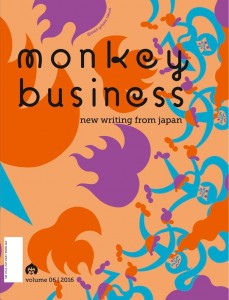
“In addition to the stories profiled here, there are other works that will make you laugh while taking you to a Japan that might not have even existed in your imagination.” (A Public Space)
By Rashaad Jorden (Yamagata-ken, 2008-10) for JQ magazine. A former head of the JETAA Philadelphia Sub-Chapter, Rashaad is a graduate of Leeds Beckett University with a master’s degree in responsible tourism management. For more on his life abroad and enthusiasm for taiko drumming, visit his blog at www.gettingpounded.wordpress.com.
Upon picking up the sixth volume of Monkey Business: New Writing from Japan, the first thought that popped into my head was that I would be introduced to epic Japanese works and/or more prominent authors from the country. After all, several award-winning writers—including Mieko Kawakami, Satoshi Kitamura and Hiroko Oyamada—produce works that appear in this volume. Quite possibly, some of the stories in this 21-piece set might become classics in Japanese literature. Or at the very least, this newbie to the Monkey Business series might discover new aspects of Japan—or be reintroduced to certain things—in rather unforgettable tales.
And well…this edition of Monkey Business doesn’t lack colorful stories. Several of them stand out, including the first one – “Forbidden Diary.” No, it doesn’t serve as an educational tour of Japanese history or culture. Instead, this excerpt of Sachiko Kishimoto’s fictional diary introduces us to a “Phantom Old Man” who has experienced Japan a little differently from the way you might have.
Let’s see…the old man (who is actually being taken care of by the narrator) remembers Shibuya as being totally void of people, as only a haven for rice paddies and without its iconic scramble crossroads. In addition to seemingly arriving out of the Stone Age, the old man repeatedly changes appearances during the story.
Justin’s Japan —Nippon in New York: LuckyRice, New York Japan CineFest, cosplay party, AnimeNEXT
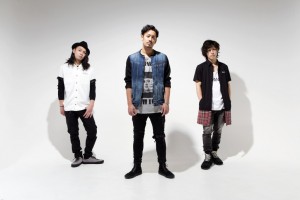
ROOKiEZ is PUNK’D returns to AnimeNEXT, coming to Atlantic City June 10-12. (Courtesy of Animenext.org)
By JQ magazine editor Justin Tedaldi (CIR Kobe-shi, 2001-02) for Examiner.com. Visit his Japanese culture page here for related stories.
After an unusually chilly spring, it’s finally starting to feel like summer. Enjoy some seasonal events this month that celebrate the best of both fine art and pop art.
This month’s highlights include:
Thursday, June 2, 8:00 p.m.-10:00 p.m.
Industry City, 233 37th Street (Brooklyn)
$88 GA, $150 VIP
Last appearing in Gotham for its Ramen Slurpfest back in October, this year’s New York Feast breathes new life this year as we move to a creative hub in Brooklyn to showcase the city’s most enticing Asian food experiences: from Southeast Asia to Western China, from fine dining global restaurants to local superstar mom and pop shops, from traditional dishes to fusion dishes that mash up culinary cultures. Enjoy tastings from over 30 curated chefs (including delectables from Pokéworks, Sushi Samba and Tuome), as well as dozens of craft cocktails, sake, beer, and beverages to keep you spirited throughout the night. VIP ticket holders gain guests one hour early admission.
June 2-3, 6:30 p.m.
Asia Society, 725 Park Avenue
$12, $10 seniors/students, $8 members
Highlighting some of the most exciting new voices in cinema, New York Japan CineFest is an annual event that features works by emerging Japanese and Japanese American filmmakers. Over two programs of short films, standouts includeTOKYO COSMO, an anime study on loneliness; Fall Seven Times, Get Up Eight: The Japanese War Brides, a real-life story about a trio of women who left Japan in the 1950s to start a new life in America; and Keino, a documentary about the eponymous custom motorcycle builder of Brooklyn’s Keino Cycles. A reception sponsored in part by Kirin Brewery of America will follow the first night’s screenings.
Saturday, June 4, 5:30 p.m.
J+B Design & Café, 300 7th Street (Brooklyn)
$8 (free for J-members)
For this Inaugural event, J-Collabo offers a very unique underground theme location for photos. Bring our own camera or have their professional photographer capture your costume! The winner of their contest will receive a special gift from J-Collabo Brooklyn. Enjoy J+B’s Nel drip coffee, Yuzu Ginger Lemon and Yuzu Ginger Ale, exquisite teas, sake, and Japanese morsels while browsing a selection of gorgeous Japanese artisanal merchandise at this neighborhood treasure chest of rare and enchanting items.
For the complete story, click here.

